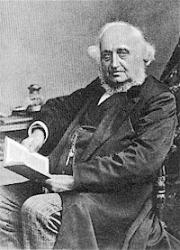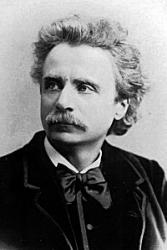Planning worship?
Check out our sister site, ZeteoSearch.org,
for 20+ additional resources related to your search.
- |
User Links
Person Results
George J. Elvey

1816 - 1893 Meter: 8.8.8.6 Composer of "ST. CRISPIN" in The Hymnal George Job Elvey (b. Canterbury, England, 1816; d. Windlesham, Surrey, England, 1893) As a young boy, Elvey was a chorister in Canterbury Cathedral. Living and studying with his brother Stephen, he was educated at Oxford and at the Royal Academy of Music. At age nineteen Elvey became organist and master of the boys' choir at St. George Chapel, Windsor, where he remained until his retirement in 1882. He was frequently called upon to provide music for royal ceremonies such as Princess Louise's wedding in 1871 (after which he was knighted). Elvey also composed hymn tunes, anthems, oratorios, and service music.
Bert Polman
George J. Elvey
D. W. Whittle

1840 - 1901 Person Name: Daniel W. Whittle Meter: 8.8.8.6 Author of "Have Faith In God" in The Cyber Hymnal [Also published under the pseudonym El Nathan.]
===============
Whittle, D. W.. Six of his hymns (Nos. 295, 308,363, 385, 386, 417) are given in I. D. Sankey's Sacred Songs and Solos, under the signature of "El Nathan."
--John Julian, Dictionary of Hymnology, Appendix, Part II (1907)
D. W. Whittle
C. R. Dunbar
1830 - 1895 Meter: 8.8.8.6 Composer of "DUNBAR" in Baptist Hymnal 2008 Rv Charles R Dunbar USA 1830-1895. Born in Pulaski,NY, he became a minister. He died in Columbus, OH.
John Perry
C. R. Dunbar
Samuel Sebastian Wesley

1810 - 1876 Meter: 8.8.8.6 Composer of "HARBRIDGE" in The Cyber Hymnal Samuel Sebastian Wesley (b. London, England, 1810; d. Gloucester, England, 1876) was an English organist and composer. The grandson of Charles Wesley, he was born in London, and sang in the choir of the Chapel Royal as a boy. He learned composition and organ from his father, Samuel, completed a doctorate in music at Oxford, and composed for piano, organ, and choir. He was organist at Hereford Cathedral (1832-1835), Exeter Cathedral (1835-1842), Leeds Parish Church (1842-1849), Winchester Cathedral (1849-1865), and Gloucester Cathedral (1865-1876). Wesley strove to improve the standards of church music and the status of church musicians; his observations and plans for reform were published as A Few Words on Cathedral Music and the Music System of the Church (1849). He was the musical editor of Charles Kemble's A Selection of Psalms and Hymns (1864) and of the Wellburn Appendix of Original Hymns and Tunes (1875) but is best known as the compiler of The European Psalmist (1872), in which some 130 of the 733 hymn tunes were written by him.
Bert Polman
Samuel Sebastian Wesley
Josiah Booth
1852 - 1930 Meter: 8.8.8.6 Composer of "LYLNWOOD" Josiah Booth (27 March 1852 – 29 December 1929) was an English organist and composer, known chiefly for his hymn-tunes.
See also in:
Wikipedia
Josiah Booth
George P. Simmonds
1890 - 1991 Person Name: George P. Simmonds, 1890- Meter: 8.8.8.6 Translator of "Tal Como Soy" in Himnos de Vida y Luz Used pseudonyms G Paul S., J. Paul Simon, and J. Pablo Símon
George P. Simmonds
Eliza H. Hamilton
Meter: 8.8.8.6 Author of "나 주 의 도 움 받 고 자 (Jesus, My Lord, to Thee I Cry)" in 찬송과 예배 = Chansong gwa yebae = Come, Let Us Worship
Eliza H. Hamilton
Anonymous
Meter: 8.8.8.6 Author of "Thou Wilt Keep Him in Perfect Peace" in Trinity Hymnal (Rev. ed.) In some hymnals, the editors noted that a hymn's author is unknown to them, and so this artificial "person" entry is used to reflect that fact. Obviously, the hymns attributed to "Author Unknown" "Unknown" or "Anonymous" could have been written by many people over a span of many centuries.
Anonymous
Ron Hamilton

1950 - 2023 Person Name: Ron Hamilton, 1950- Meter: 8.8.8.6 Composer of "MAC" in Rejoice Hymns In honor and memory of Ron ("Patch the Pirate") Hamilton (1950-2023), the American Christian musician, lyricist, composer, and president and owner of Majesty Music, who passed away last week on April 19, the posts this week will be about him.
After finishing high school, in 1969 Ron went on to Bob Jones University (BJU) in Greenville, SC, where he received a BA in Church Music in 1973, followed by an MA in Church Music Composition. While at BJU Ron met Shelly Garlock at vesper choir, directed by her father, Dr. Frank Garlock; it was "love at first sight" and six years later, on May 31, 1975, they were married. They have five children: Jonathan, Tara, Alyssa, Megan, and Jason. Immediately, they began working at Majesty Music, a Christian music publishing house founded by Dr. Garlock. (Sources: Patch the Pirate Facebook page, Wikipedia)
One of Ron Hamilton's songs that depicts well his life is "Faithful Men":
I am looking to Jesus, giving all in the race,
Pressing upward to gain the heavenly prize.
Faithful men are my witness, who have struggled and died;
And they watch from the grandstand in the skies.
(Refrain)
Faithful men have gone before us,
Faithful men who fight and stand;
I want to follow in their footsteps,
Guided by those faithful men.
Jacob joined with the faithful;
Joseph followed behind;
Moses ran with the mighty men of old.
There were David and Daniel; then came Peter and Paul.
Now they chant as they run on streets of gold.
Refrain
(Majesty Hymns, p. 380)
--from an obituary on the Facebook group "Hymns and Hymnwriters"
Ron Hamilton
Edvard Grieg

1843 - 1907 Person Name: Edward H. Grieg Meter: 8.8.8.6 Arranged of "BEHOLD A HOST" in Christian Classics Ethereal Hymnary Edvard Hagerup Grieg Born at Bergen, Norway, of Scottish descent, son of a merchant and vice-consul in Bergen, his mother was a music teacher. He became a pianist and composer, with his standard classical repertoire known worldwide. He developed Norwegian folk music into his own compositions, helping to develop a national musical identity. As a child his mother taught him piano from age six. He attended several schools. His uncle, a Norwegian violinist, recognized his nephew’s talents at age 15 and urged his parents to send him to the Leigzig Conservatory in Germany. He enrolled there and concentrated on piano. He enjoyed the many concerts and recitals given in Leipzig. He disliked the discipline of the conservatory course of study, but he loved the organ, mandatory for piano students. In 1860 he survived a life-threatening lung disease, pleurisy and tuberculosis. Throughout life, his health was impaired by a destroyed left lung and disformity of his thoracic spine. He suffered numerous respiratory infections, and ultimately developed combined heart and lung failure. He was admitted many times for various spas and sanatoria in both Norway and abroad. Several of his doctors became close friends. In 1861 he made his debut as a concert pianist at Karlshamm, Sweden. He finished Leipzig studies in 1862 and held a concert in his hometown, playing Beethoven’s ‘Pathetique’ sonata. In 1863 he went to Copenhagen, Denmark, remaining there three years. There he met Danish composers and a fellow Norwegian composer, Rikard Nordraak, who wrote the Norwegian National Anthem. When Nordraak died in 1866, Grieg composed a funeral march in his honor. In 1867 Grieg married his first cousin, Nina Hagerup. Their only child, Alexandra, was born the following year. She died from meningitis at age two. In 1868 he wrote his Piano Concerto in A-minor. It was performed by Edmund Nuepert in Copenhagen because Grieg was in Norway at the time, fulfilling other commitments. In 1868 Franz Liszt, not yet having met Grieg, wrote a testimonial of him, resulting in Grieg’s obtaining a travel grant. The two met in Rome in 1870. Each was impressed with the other’s musical accomplishments. Grieg had close ties with the Bergen Philharmonic Orchestra and became its leader 1880-1882. In 1888 Grieg met Tchaikovsky in Leipzig. He was struck by Tchaikovsky’s sadness. Tchaikovsky praised Grieg’s music. The Norwegian government awarded Grieg a pension. In 1903 he made gramophone recordings of his piano music in Paris, France. He also made live piano music rolls for the Hupfeld Phonola piano-player system and Weldt-Mignon reproducing system. He also worked with the Aeolian Company for its ‘Autograph Metro-style’ piano roll series, wherein he indicated the tempo mapping of many of his pieces. In 1906 he met pianist and composer, Percy Grainger, in London. Grainger was an admire of Grieg’s music, and they developed a strong empathy for each other. Grieg wrote of Grainger: “I have written Norwegian dances that no one in my country can play, and here comes this Australian who plays them as they ought to be played. He is a genius that we Scandinavians cannot do other than love.” Grieg and his wife considered themselves Unitarians, and attended that church denomination. When Grieg died after a long illness, at age 64, his funeral drew more than 30,000 people in his hometown, who came out to honor him. His own funeral march, in honor of Nordraak, was played, along with a 2nd march, by his friend, Johan Halvorsen, who married Grieg’s niece. Grieg was cremated, with ashes entombed in a mountain crypt. Later, his wife’s were placed with his.
John Perry
Edvard Grieg


 My Starred Hymns
My Starred Hymns


